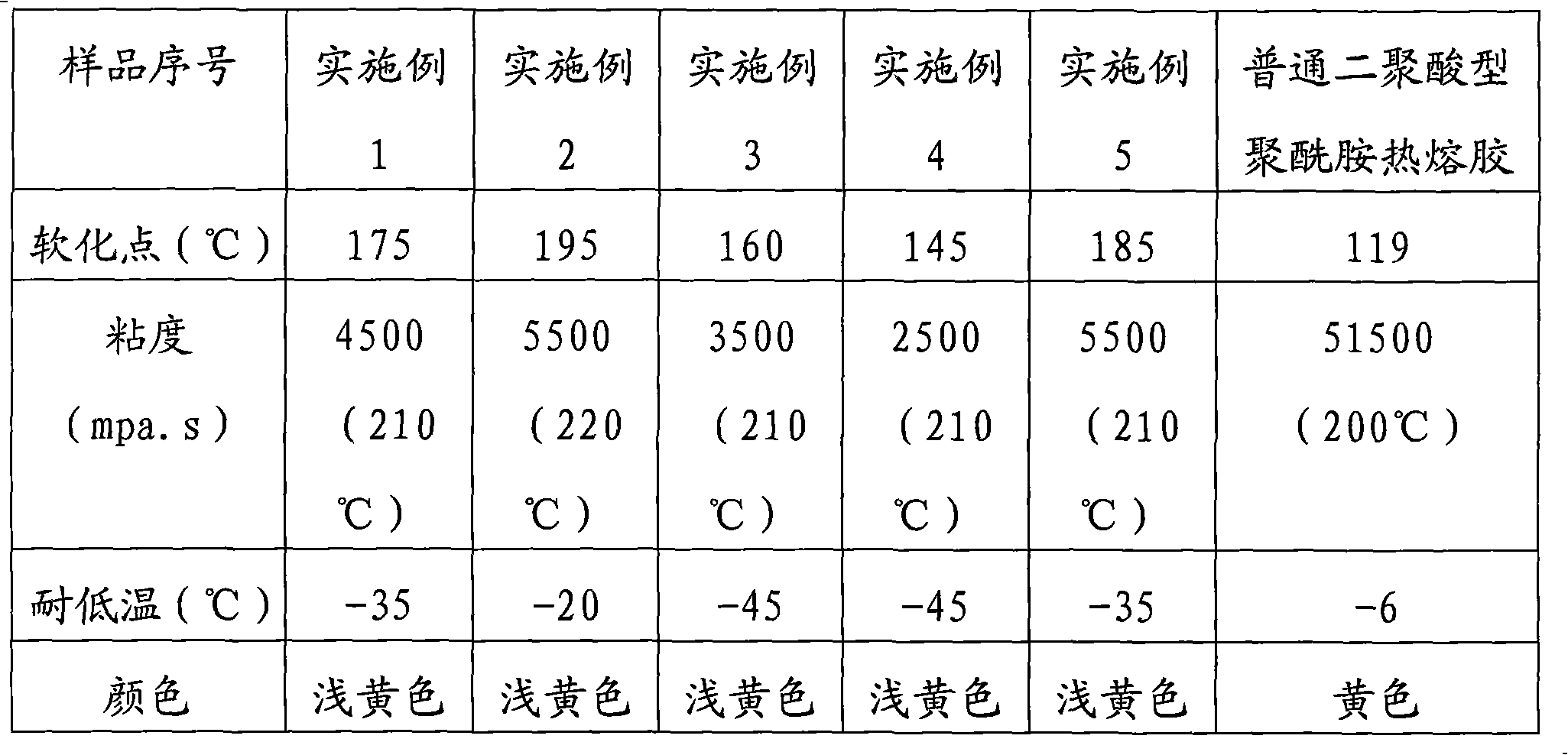Low-viscosity dimer acid type polyamine hot melt adhesive and preparation method thereof
A technology of polyamide hot melt adhesive and dimer acid type, which is applied in adhesives, non-polymer adhesive additives, adhesive additives, etc. It can solve the problems of high temperature viscosity, unfavorable molding, volatile diamine, and low temperature resistance. Poor and other problems, to achieve good high and low temperature resistance and mechanical properties, low amine volatilization, low water absorption effect
- Summary
- Abstract
- Description
- Claims
- Application Information
AI Technical Summary
Problems solved by technology
Method used
Image
Examples
Embodiment 1
[0031] Add 150.00g of hydrogenated dimer acid, 25.50g of sebacic acid, 18.12g of polyetheramine D-230, 39.40g of polyetheramine D-2000 into a 500mL four-necked flask equipped with a thermometer, stirrer, condensing reflux and nitrogen tube , 15.00g of water, 1.8g of tetrakis [β-(3,5-di-tert-butyl-4-hydroxyphenyl) propionate] pentaerythritol ester, 1.20g of propionic acid, and 17.70g of ethylenediamine into the constant pressure In the dropping funnel, put in nitrogen gas and stir to start heating, raise the temperature to 120°C within 30 minutes, and slowly add ethylenediamine dropwise at this temperature, complete the dropwise addition within 40 minutes, then the temperature rises to 130°C, Form salt at this temperature for 2 hours, then slowly increase the temperature, during which water will evaporate, and the temperature will rise to 240°C within 3 hours, keep at this temperature for 2 hours, and then use a vacuum pump to evacuate for 2 hours to a pressure of 100 Pa, and f...
Embodiment 2
[0033] Add 161.10g of dimer acid, 25.40g of adipic acid, 17.20g of polyetheramine D-230, and 28.00g of polyetheramine D-2000 into a 500mL four-necked flask with a thermometer, stirrer, condenser and nitrogen tube , 12.00g water, 1.0g tetrakis[β-(3,5-di-tert-butyl-4-hydroxyphenyl) propionate] pentaerythritol ester, 0.6g tris(2,4-di-tert-butylphenyl) phosphite Esters, 2.20g of n-hexanoic acid, and 22.70g of ethylenediamine were put into a constant pressure dropping funnel, and nitrogen gas was introduced to stir and start heating, and the temperature was raised to 120°C within 60 minutes, and slowly added dropwise at this temperature Ethylenediamine, the dropwise addition is completed within 60 minutes. At this time, the temperature rises to 130°C and forms a salt at this temperature for 2 hours, and then slowly raises the temperature. During this process, water will evaporate, and the temperature rises to within 3 hours. 280°C, kept at this temperature for 5 hours, then evacuat...
Embodiment 3
[0035] Add 148.60g of dimer acid, 12.00g of sebacic acid, 11.30g of polyetheramine D-230, 65.63g of polyetheramine D-2000 into a 500mL four-neck flask equipped with a thermometer, stirrer, condenser and nitrogen tube , 12.00g water, 1.2g tetrakis[β-(3,5-di-tert-butyl-4-hydroxyphenyl) propionate] pentaerythritol ester, 0.3g hypophosphorous acid, 4.2g stearic acid, and 18.24g propylene glycol Put the amine into the constant pressure dropping funnel, feed in nitrogen gas and stir to start heating, raise the temperature to 110°C within 50 minutes, and slowly add propylenediamine dropwise at this temperature, and complete the dropwise addition within 70 minutes, at this time Raise the temperature to 130°C, and form salt at this temperature for 2 hours, and then slowly raise the temperature, during which water will evaporate, and the temperature will rise to 220°C within 2 hours, keep at this temperature for 1 hour, and then use The vacuum pump was evacuated for 3 hours to a pressur...
PUM
 Login to View More
Login to View More Abstract
Description
Claims
Application Information
 Login to View More
Login to View More - R&D
- Intellectual Property
- Life Sciences
- Materials
- Tech Scout
- Unparalleled Data Quality
- Higher Quality Content
- 60% Fewer Hallucinations
Browse by: Latest US Patents, China's latest patents, Technical Efficacy Thesaurus, Application Domain, Technology Topic, Popular Technical Reports.
© 2025 PatSnap. All rights reserved.Legal|Privacy policy|Modern Slavery Act Transparency Statement|Sitemap|About US| Contact US: help@patsnap.com

